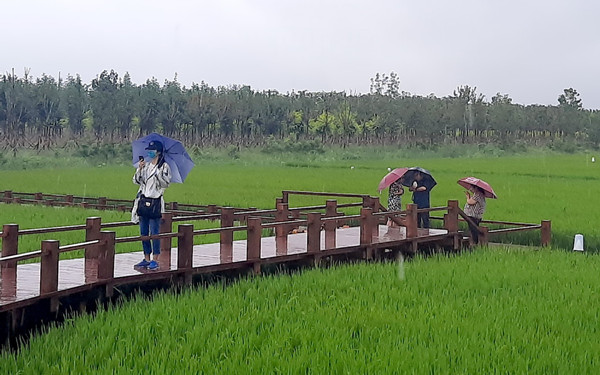Environmental progress across the eastern coastal lowlands of Tianjin

Northern China's Tianjin is certainly more than just a city; indeed, it is a truly fascinating and indeed diverse municipality covering 11,760 square kilometers. Its topography encompasses a wide variety of landscapes stretching from a mountainous section of the Great Wall in the north to vast stretches of low-lying, indeed flat land, bordering the Bohai Sea. The main urban center and historic core of Tianjin sit on this plain. It straddles the Haihe River, which historically connected Beijing, via the Grand Canal, with the sea. The plains also incorporate countless villages along with several beautiful water towns.
Recently, I had an opportunity to travel eastwards from downtown, through Jinnan district crossing extensive wetland areas to reach the core of Binhai New Area close to the Haihe estuary. As a geographer, I found the journey truly fascinating - yes, flat landscapes can be fascinating when looked at closely.
Crisscrossed by a maze of waterways, some navigable by small crafts, the terrain is only a few meters at most, above sea level. Go back in time, less than 2000 years ago, there was little, if any, land visible. The plain contains great depths of river-borne alluvium - sediments carried down over time from inland mountain ranges such as the Taihang, even the yellow soil of Shaanxi. Gradually, deposition led to marshes, and eventually land appeared.– This process of sedimentation is still going on beyond the Bohai Sea's present-day shores. Over time, despite this "new" land not particularly suited for large urban settlements, many of the meandering streams were straightened and land reclaimed for farming around small villages. Fishing was important along with salt beds, the latter a significant factor for Tianjin's historic strong economic growth. However, some industrialization also appeared during the early 20th century, constructed with sadly little concern for the local environment. Areas of the wetlands degraded.
The scene today is very different, with environmental consideration becoming a top priority in China. This is something I have noticed increasingly in recent years. The skies above Tianjin and Beijing clearly show this. Gone are the days of somber grays with poor air quality, today we look upwards more often to blue.
In and around Tianjin, I have witnessed closely several projects transforming formerly rundown landscapes into first-class assets for the people. An obvious example is the Haihe River, whose banks have been transformed into a quite beautiful linear corridor. Parks within downtown have emerged from where older industries once operated. In Binhai's Teda area, earlier this year, I visited an example of such rejuvenation, Taifeng Park, which is quite close to Tianjin Port.
On this recent tour, there was an opportunity to walk through and experience some of the extensive development, such as the Bailiwan green belt. So far, 3 billion yuan has been spent to transform a formerly neglected landscape into pristine conditions boasting over 550,000 trees; lakes now rich in fish; stretches of reclaimed farmland; and more. Jinnan is at the center of a 736 square kilometer "green district" stretching across five adjoining districts of Tianjin. The aim is to create an extensive ecological zone running from downtown Tianjin to the coastal areas, including Binhai. It is aimed also as one of the projects benefitting the environment and ecology of the Beijing-Tianjin-Hebei region.

Copyright ©
Tianjin Municipal Government. All rights reserved. Presented by China Daily.
京ICP备13028878号-35

